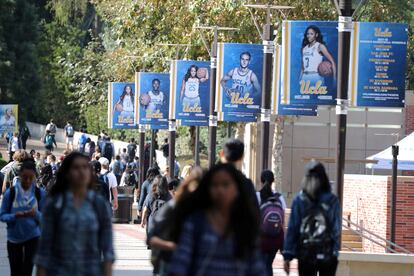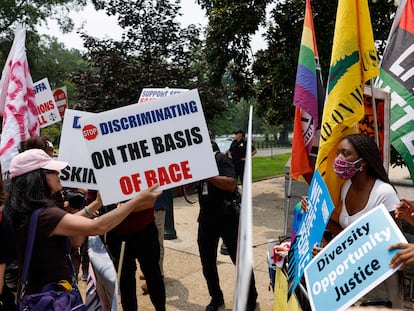California shows the United States a future without affirmative action
Known for its diversity, the state abolished the measure 27 years ago despite efforts to revive it


All eyes turned to California after the United States Supreme Court recently ruled that colleges and universities may no longer take race into account when making admissions decisions. Legal scholars predict that institutions of higher education around the country will emulate California’s public universities, which prohibited the use of race as an admission criterion 27 years ago. However, the Supreme Court ruling will affect prestigious private institutions in California like Stanford University, the University of Southern California and Pomona College.
“Positive discrimination [affirmative action] didn’t really respond to the endemic problem of exclusion in the educational system,” said Raquel Aldana, a law professor at the University of California, Davis. The Supreme Court’s long-awaited verdict, following an arduous eight-year trial, came as no shock to Californians as it was the culmination of a relentless, decades-long battle to eradicate affirmative action. It’s a familiar topic at the university where Aldana teaches. In 1973, a 32-year-old engineer sued the State of California for “reverse discrimination” after being rejected two years in a row by the UC Davis School of Medicine, despite having higher grades than some candidates who were accepted.
His name is Allan Bakke, a White man with impressive qualifications, to use one of the words that comes up frequently in the affirmative action debate. He had served in the Navy and worked in a NASA laboratory when he decided to change careers and pursue medicine. Bakke’s lawsuit argued that he would have been admitted if UC Davis hadn’t reserved 16% of its first-year slots for racial minority applicants. The Supreme Court ruled in his favor in 1978 and Bakke started medical school at the age of 38. He graduated as an anesthesiologist four years later and never publicly spoke about the case.
The decision dealt a blow to the quota system, prohibiting race from being the sole determinant for admission to education. It also set a precedent that had an impact on the delicate social fabric of a diverse country. Although Aldana calls it an “imperfect tool,” positive discrimination formed part of this intricate mosaic and sought to rectify an unjust system.
“Latinos are the main target of the attack on affirmative action,” said attorney Thomas Saenz, who graduated summa cum laude from Yale University. “And that’s because we’re a growing population that’s perceived as a threat. In contrast, the African-American population is increasing at a lower rate,” said Saenz, who has served as president of the Mexican American Legal Defense and Educational Fund (MALDEF) for the past 14 years.
The death blow to affirmative action in California was championed by Ward Connerly in 1996. Connerly, who owned a consulting and land-use planning company, was appointed to the University of California Board of Regents in 1993. The Board of Regents is the governing body for the California state university system, which has over 280,000 students in nine campuses. Connerly, who was orphaned at four, embodied the American dream and defied extreme poverty in Louisiana. His remarkable success in business reinforced his message that the very tools intended to address racial injustice were exacerbating the problem. Connerly was close friends with Pete Wilson, the influential Republican governor who played a pivotal role in garnering party-wide support for the cause, which required one million signatures for a referendum to be placed on the ballot.
With 55% of the vote in favor of Proposition 209, California buried affirmative action once and for all, prohibiting consideration of race and ethnicity in hiring. The measure affected the entire public sector, from government offices to all levels of the public education system. While 76% of California’s Latino population voted against Proposition 209 in 1996, its percentage of the electorate was less than the 27% it represents today.
Following Proposition 209, California’s universities underwent significant transformations to foster diversity. The demographics of the state played a pivotal role in driving this change. With over half of high school graduates identifying as Latino, a majority of them pursued higher education in technical schools that offer comprehensive two-year programs. Despite constituting 40% of California’s population, only 5- 6% are able to secure spots in prestigious universities. This disparity underscores the need for continued efforts to ensure equitable access to higher education for all. “Are you going to tell me that this counts as racial justice? Trust me, it’s not even close. Sure, the University of California may boast about its diversity because it educates a measly few [8% of students in the state]. But let’s face it, in terms of real numbers, we’ve got some serious representation issues,” said Raquel Aldana. Texas exhibits a similar educational system disparity, with Latinos comprising 40% of the population but only representing 20% at the University of Texas.
Over the course of nearly three decades, the University of California campuses have evolved into a vibrant and diverse experimentation laboratory. Currently, the student body consists of 32% Asian students, followed by Latinos at 22.5% and Whites at 22.2%. Black students make up 4.5% of the student body. Experts say $500 million is allocated annually to diversity programs. Admissions procedures have also been changed for the approximately 60,000 applicants that compete for 2,000 spots every year.
Eliminating standardized exams
In a bold move, the state’s top educational institutions decided to do away with standardized exams. They no longer see them as accurate measures of reading comprehension or mathematical abilities, and fail to adequately assess problem-solving skills and creativity. Leading the charge is the University of California, which is gradually reducing the weight of these exams in admissions, and will completely eliminate the requirement in 2025. A comprehensive set of 12 admission criteria will be used instead that consider factors like “special talents” in the visual arts, interest in other cultures, active community involvement and whether applicants live in an area with poor accessibility for people with mobility challenges.
Educational institutions across the country are also opting out of the popular university rankings published by US News & World Report. Last year, 35 million people read these rankings which many consider arbitrary and can skew an applicant’s priorities. Institutions that will no longer submit data for inclusion in the rankings included 14 prestigious law and medical schools, among them Yale, Columbia, Harvard, Stanford and the University of Pennsylvania.
According to Thomas Saenz and other experts, there are still numerous challenges that need to be addressed. The president of MALDEF specifically highlights the weighted grade point average (GPA), which considers extracurricular activities and private tutoring in its calculation. “Those factors have a pretty big bias, but they’re still important factors in admission processes, just like the recommendations from tutors and professors that also have unconscious biases.”
In 2020, Saenz and his organization led the charge to repeal Proposition 209. The Proposition 16 campaign garnered widespread support and collected $20 million in funding to earn a place on the ballot. Nevertheless, by a 57% majority, California voters chose to keep Proposition 209. Saenz attributes this outcome to various factors, especially the lack of time during the pandemic to effectively communicate the benefits of diversity measures to the electorate. After 24 years, Saenz says most voters in California have never experienced the favorable effects of affirmative action. Surveys revealed a divided opinion among the Latino population.
While the Supreme Court ruling will have little impact on public universities in California, Saenz says it will also perpetuate one of the great fallacies of the state’s higher education. “There’s this belief that our admissions system is merit-based. But let me tell you, it’s not! A lot of the criteria that superficially seem neutral are not, because they don’t actually identify who’s most likely to succeed in college and beyond. And we’re here to fight that myth,” said Saenz.
Sign up for our weekly newsletter to get more English-language news coverage from EL PAÍS USA Edition
Tu suscripción se está usando en otro dispositivo
¿Quieres añadir otro usuario a tu suscripción?
Si continúas leyendo en este dispositivo, no se podrá leer en el otro.
FlechaTu suscripción se está usando en otro dispositivo y solo puedes acceder a EL PAÍS desde un dispositivo a la vez.
Si quieres compartir tu cuenta, cambia tu suscripción a la modalidad Premium, así podrás añadir otro usuario. Cada uno accederá con su propia cuenta de email, lo que os permitirá personalizar vuestra experiencia en EL PAÍS.
¿Tienes una suscripción de empresa? Accede aquí para contratar más cuentas.
En el caso de no saber quién está usando tu cuenta, te recomendamos cambiar tu contraseña aquí.
Si decides continuar compartiendo tu cuenta, este mensaje se mostrará en tu dispositivo y en el de la otra persona que está usando tu cuenta de forma indefinida, afectando a tu experiencia de lectura. Puedes consultar aquí los términos y condiciones de la suscripción digital.
More information
Archived In
Últimas noticias
Welcome to the post-religion era: The idea of Christianity as the absolute truth has become obsolete
‘I thought you would like it’: The risky sexual practice popularized by TV shows and TikTok
The digitalization of tourism: ‘They promise experiences and gave us the worst possible one’
Mexican peso defies uncertainty with forecasts of a new period of stability in 2026
Most viewed
- Sinaloa Cartel war is taking its toll on Los Chapitos
- Reinhard Genzel, Nobel laureate in physics: ‘One-minute videos will never give you the truth’
- Oona Chaplin: ‘I told James Cameron that I was living in a treehouse and starting a permaculture project with a friend’
- Why the price of coffee has skyrocketed: from Brazilian plantations to specialty coffee houses
- Silver prices are going crazy: This is what’s fueling the rally










































